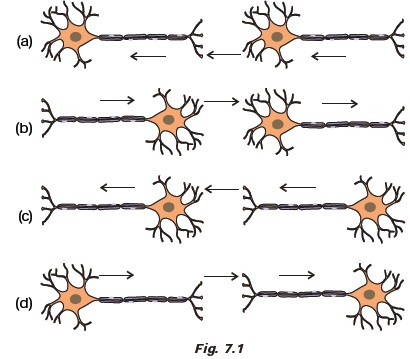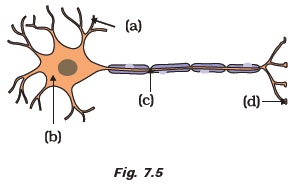Class 10 Important Questions for Science – Control and Coordination
NCERT Exemplar Class 10 Science is very important resource for students preparing for X Board Examination. Here we have provided NCERT Exemplar Problems Solutions along with NCERT Exemplar Problems Class 10.
Question from very important topics are covered by NCERT Exemplar Class 10. You also get idea about the type of questions and method to answer in your Class 10th examination.
Here you can get Class 10 Important Questions Science based on NCERT Text book for Class X. Science Class 10 Important Questions are very helpful to score high marks in board exams. Here we have covered Important Questions on Control and Coordination for Class 10 Science subject.
Science Important Questions Class 10 are given below.
Multiple Choice Questions
- Which of the following statements is correct about receptors?
- (a) Gustatory receptors detect taste while olfactory receptors detect smell
- (b) Both gustatory and olfactory receptors detect smell
- (c) Auditory receptors detect smell and olfactory receptors detect taste
- (d) Olfactory receptors detect taste and gustatory receptors smell
- Electrical impulse travels in a neuron from
- (a) Dendrite → axon → axonal end → cell body
- (b) Cell body → dendrite → axon → axonal end
- (c) Dendrite → cell body → axon → axonal end
- (d) Axonal end → axon → cell body → dendrite
- In a synapse, chemical signal is transmitted from
- (a) dendritic end of one neuron to axonal end of another neuron
- (b) axon to cell body of the same neuron
- (c) cell body to axonal end of the same neuron
- (d) axonal end of one neuron to dendritic end of another neuron
- In a neuron, conversion of electrical signal to a chemical signal occurs at/in
- (a) cell body
- (b) axonal end
- (c) dendritic end
- (d) axon
- Which is the correct sequence of the components of a reflex arc?
- (a) Receptors→ Muscles→ Sensory neuron→ Motor neuron→ Spinal cord
- (b) Receptors→ Motor neuron → Spinal cord → Sensory neuron → Muscle
- (c) Receptors → Spinal cord → Sensory neuron → Motor neuron → Muscle
- (d) Receptors → Sensory neuron → Spinal cord → Motor neuron → Muscle
- Which of the following statements are true?
(i) Sudden action in response to something in the environment is called reflex action
(ii) Sensory neurons carry signals from spinal cord to muscles
(iii) Motor neurons carry signals from receptors to spinal cord
(iv) The path through which signals are transmitted from a receptor to a muscle or a gland is called reflex arc- (a) (i) and (ii)
- (b) (i) and (iii)
- (c) (i) and (iv)
- (d) (i) , (ii) and (iii)
- Which of the following statements are true about the brain?
(i) The main thinking part of brain is hind brain
(ii) Centres of hearing, smell, memory, sight etc are located in fore brain.
(iii) Involuntary actions like salivation, vomiting, blood pressure are controlled by the medulla in the hind brain
(iv) Cerebellum does not control posture and balance of the body- (a) (i) and (ii)
- (b) (i), (ii) and (iii)
- (c) (ii) and (iii)
- (d) (iii) and (iv)
- Posture and balance of the body is controlled by
- (a) cerebrum
- (b) cerebellum
- (c) medulla
- (d) pons
- Spinal cord originates from
- (a) cerebrum
- (b) medulla
- (c) pons
- (d) cerebellum
- The movement of shoot towards light is
- (a) geotropism
- (b) hydrotropism
- (c) chemotropism
- (d) phototropism
- The main function of abscisic acid in plants is to
- (a) increase the length of cells
- (b) promote cell division
- (c) inhibit growth
- (d) promote growth of stem
- Which of the following is not associated with growth of plant?
- (a) Auxin
- (b) Gibberellins
- (c) Cytokinins
- (d) Abscisic acid
- Iodine is necessary for the synthesis of which hormone?
- (a) Adrenaline
- (b) Thyroxin
- (c) Auxin
- (d) Insulin
- Choose the incorrect statement about insulin
- (a) It is produced from pancreas
- (b) It regulates growth and development of the body
- (c) It regulates blood sugar level
- (d) Insufficient secretion of insulin will cause diabetes
- Select the mis-matched pair
- (a) Adrenaline : Pituitary gland
- (b) Testosterone: Testes
- (c) Estrogen : Ovary
- (d) Thyroxin : Thyroid gland
- The shape of guard cells changes due to change in the
- (a) protein composition of cells
- (b) temperature of cells
- (c) amount of water in cells
- (d) position of nucleus in the cells
- The growth of tendril in pea plants is due to
- (a) effect of light
- (b) effect of gravity
- (c) rapid cell divisions in tendrillar cells that are away from the support
- (d) rapid cell divisions in tendrillar cells in contact with the support
- The growth of pollen tubes towards ovules is due to
- (a) hydrotropism
- (b) chemotropism
- (c) geotropism
- (d) phototropism
- The movement of sunflower in accordance with the path of sun is due to
- (a) phototropism
- (b) geotropism
- (c) chemotropism
- (d) hydrotropism
- The substance that triggers the fall of mature leaves and fruits from plants is due to
- (a) auxin
- (b) gibberellin
- (c) abscisic acid
- (d) cytokinin
- Which of the following statements about transmission of nerve impulse is incorrect?
- (a) Nerve impulse travels from dendritic end towards axonal end
- (b) At the dendritic end electrical impulses bring about the release of some chemicals which generate an electrical impulse at the axonal end of another neuron
- (c) The chemicals released from the axonal end of one neuron cross the synapse and generate a similar electrical impulse in a dendrite of another neuron
- (d) A neuron transmits electrical impulses not only to another neuron but also to muscle and gland cells
- Involuntary actions in the body are controlled by
- (a) medulla in fore brain
- (b) medulla in mid brain
- (c) medulla in hind brain
- (d) medulla in spinal cord
- Which of the following is not an involuntary action?
- (a) Vomiting
- (b) Salivation
- (c) Heart beat
- (d) Chewing
- When a person is suffering from severe cold, he or she cannot
- (a) differentiate the taste of an apple from that of an ice cream
- (b) differentiate the smell of a perfume from that of an agarbatti
- (c) differentiate red light from green light
- (d) differentiate a hot object from a cold object
- What is the correct direction of flow of electrical impulses?

- Which statement is not true about thyroxin?
- (a) Iron is essential for the synthesis of thyroxine
- (b) It regulates carbohydrates, protein and fat metabolism in the body
- (c) Thyroid gland requires iodine to synthesise thyroxin
- (d) Thyroxin is also called thyroid hormone
- Dwarfism results due to
- (a) Excess secretion of thyroxin
- (b) Less secretion of growth hormone
- (c) Less secretion of adrenaline
- (d) Excess secretion of growth hormone
- Dramatic changes of body features associated with puberty are mainly because of secretion of
- (a) oestrogen from testes and testosterone from ovary
- (b) estrogen from adrenal gland and testosterone from pituitary gland
- (c) testosterone from testes and estrogen from ovary
- (d) testosterone from thyroid gland and estrogen from pituitary gland
- A doctor advised a person to take an injection of insulin because
- (a) his blood pressure was low
- (b) his heart was beating slowly
- (c) he was suffering from goitre
- (d) his sugar level in blood was high
- The hormone which increases the fertility in males is called
- (a) oestrogen
- (b) testosterone
- (c) insulin
- (d) growth hormone
- Which of the following endocrine glands is unpaired?
- (a) Adrenal
- (b) Testes
- (c) Pituitary
- (d) Ovary
- Junction between two neurons is called
- (a) cell junction
- (b) neuro muscular junction
- (c) neural joint
- (d) synapse
- In humans, the life processes are controlled and regulated by
- (a) reproductive and endocrine systems
- (b) respiratory and nervous systems
- (c) endocrine and digestive systems
- (d) nervous and endocrine systems
Short Answer Type Questions
- Label the parts (a), (b), (c) and (d) and show the direction of flow of electrical signals in Figure 7.2.

- Name the plant hormones responsible for the following
- (a) elongation of cells
- (b) growth of stem
- (c) promotion of cell division
- (d) falling of senescent leaves.
- Label the endocrine glands in Figure 7.3.

- In Figure 7.4 (a), (b) and (c), which appears more accurate and why?

- Label the parts of a neuron in Figure 7.5.

- Match the terms of Column (A) with those of Column (B)

- What is a tropic movement? Explain with an example.
- What will happen if intake of iodine in our diet is low?
- What happens at the synapse between two neurons?
- Answer the following :
- (a) Which hormone is responsible for the changes noticed in females at puberty?
- (b) Dwarfism results due to deficiency of which hormone?
- (c) Blood sugar level rises due to deficiency of which hormone?
- (d) Iodine is necessary for the synthesis of which hormone?
- Answer the following :
- (a) Name the endocrine gland associated with brain?
- (b) Which gland secretes digestive enzymes as well as hormones?
- (c) Name the endocrine gland associated with kidneys?
- (d) Which endocrine gland is present in males but not in females?
Long Answer Type Questions
- Draw the structure of a neuron and explain its function.
- What are the major parts of the brain? Mention the functions of different parts.47. What constitutes the central and peripheral nervous systems? How
are the components of central nervous system protected? - Mention one function for each of these hormones :
- (a) Thyroxin
- (b) Insulin
- (c) Adrenaline
- (d) Growth hormone
- (e) Testosterone.
- Name various plant hormones. Also give their physiological effects on plant growth and development.
- What are reflex actions? Give two examples. Explain a reflex arc.
- “Nervous and hormonal systems together perform the function of control and coordination in human beings.” Justify the statement.
- How does chemical coordination take place in animals?
- Why is the flow of signals in a synapse from axonal end of one neuron to dendritic end of another neuron but not the reverse?
| « Previous | Next » |
Answers to Multiple Choice Questions
Multiple Choice Questions

Short Answer Questions


Long Answer Questions


Class 10 Important Questions for Science all topics
Science Important Questions Class 10 are given below chapter wise.
- Chemical Reactions and Equations
- Acids, Bases and Salts
- Metals and Non-Metals
- Carbon and Its Compounds
- Periodic Classification Of Elements
- Life Processes
- Control and Coordination
- How Do Organisms Reproduce?
- Heredity and Evolution
- Light – Reflection and Refraction
- Human Eye and Colourful World
- Electricity
- Magnetic Effects Of Electric Current
- Sources Of Energy
- Our Environment
- Management Of Natural Resources
Other Study Material
To get study material, exam alerts and news, join our Whatsapp Channel.

